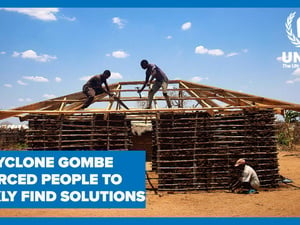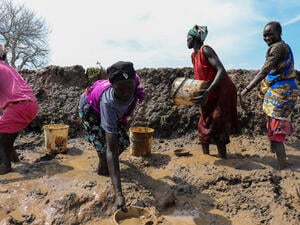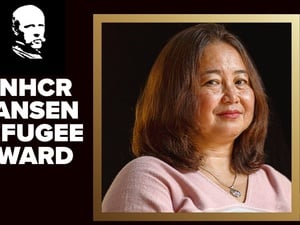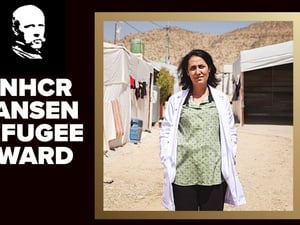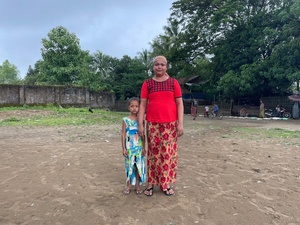UNHCR Fears Mosul, Hawiga Fighting will Trigger Displacement Wave
UNHCR Fears Mosul, Hawiga Fighting will Trigger Displacement Wave

Iraqi families flee east Mosul through the recently liberated Mosul University complex.
Agency steps up plans to respond, with partners, to expected spike in numbers fleeing
UNHCR, the UN Refugee Agency, other agencies and partners are co-ordinating plans to respond to a potential significant new flight of displaced Iraqis escaping the latest phase in the military offensive in western Mosul.
As many as 250,000 Iraqis could be displaced from their homes with the anticipated escalation of conflict in densely-populated western Mosul. Some 161,178 people have been displaced from Mosul and surrounding areas since October 17. The majority, some 83 percent, are in camps and emergency sites, while the remainder are living among host communities or at informal sites.
UNHCR has seven camps completed and two under construction. UNHCR is currently able to provide some 11,000 families (66,000 people) with shelter as part of the Mosul response, a figure which should expand to 20,000 families (120,000 individuals) in the near-term, once land is allocated. The Agency continues to seek additional land for new camps, reception and transit areas, to assist people closer to Mosul. By the end of March, it is anticipated that the Government of Iraq, working with UNHCR and its partners, could potentially host 41,155 families (246,930 people) in camps and emergency sites.
Since October, nearly 30,000 people from Mosul and surrounding areas have returned to their places of origin, including from Hasansham and Khazer camps, east of Mosul. Returnees are keen to resume their lives and told UNHCR that the re-opening of schools and government offices was a factor in their decision to return. In some areas, security and the lack of food and water remain a concern. Some returnees continue to rely on emergency relief items, including kerosene, which they received while in camps.
In recent days, UNHCR staff in Hasansham and Khazer camps reported that several families have in fact come back to the camps, after they had returned to their own neighbourhoods in eastern Mosul. Those families said they had decided to return because of lack of services and bad conditions in their place of origin. Some newly-accessible neighbourhoods of Mosul have been affected by shelling from armed groups in western Mosul, resulting in fresh displacement. UNHCR continues to advocate for returns to newly accessible areas to be voluntary, non-discriminatory and safe.
UNHCR is also assisting increasing numbers fleeing Hawiga, 130 km south east of Mosul, due deteriorating living conditions and the expected intensification of military operations. Inter-agency planning estimates predict that up to 114,000 individuals could be displaced from Hawiga. So far, 82,128 people have fled since August 2016. Until recently, people had been leaving Hawiga in smaller numbers but hundreds are now fleeing eastwards daily towards Salah al-Din and Kirkuk. Those leaving Hawiga face grave dangers including ambushes, improvised explosive devices (IEDs) and unexploded ordnance, especially moving across the Hamreen Mountains. Most travel at night to evade checkpoints and armed groups, which adds to dangers. UNHCR has received reports of kidnappings, fatalities from IEDs and deaths of children along the way. Family separation, especially as a result of security screening, compounds the risk of sexual or gender-based violence. The humanitarian community continues to call on all parties to respect and uphold the principles of international humanitarian law and to ensure the protection of civilians.
In Kirkuk, most recent arrivals are from Hawiga and are in camps (6,421 families / 38,526 individuals). Additionally, some 35,814 internally displaced persons (IDPs) from Hawiga are in Salah al-Din governorate, with significant concentrations in Tikrit, Shirqat, Balad and Samarra. IDPs are also finding shelter in unfinished structures, public buildings or rented houses.
Protection, Funding
The needs of people lacking identification documents remains a major challenge. UNHCR protection monitoring teams have assessed over 52,000 individuals among the Mosul displaced and 46 percent were missing documents, including birth or marriage registration and civil ID cards. Unless their situation is regularised, these people cannot be sponsored by relatives, leave camps or seek work. UNHCR continues to advocate with the authorities and work through legal partners to facilitate issuing new documents.
UNHCR’s 2016 Mosul emergency response appeal for US$196 million was 57 percent funded. For 2017, we are seeking US$578 million for our work with Iraqi IDPs and Iraqi refugees in the region.
UNHCR has distributed emergency items, including quilts and blankets, to more than 178,000 people, and provided nearly 53,000 people affected by the Mosul conflict with protection assistance.
For more information on this topic, please contact:
- In Geneva, Matthew Saltmarsh, [email protected], +41 79 217 3140
- In Bagdad, Caroline Gluck, [email protected], +964 780 920 7286


